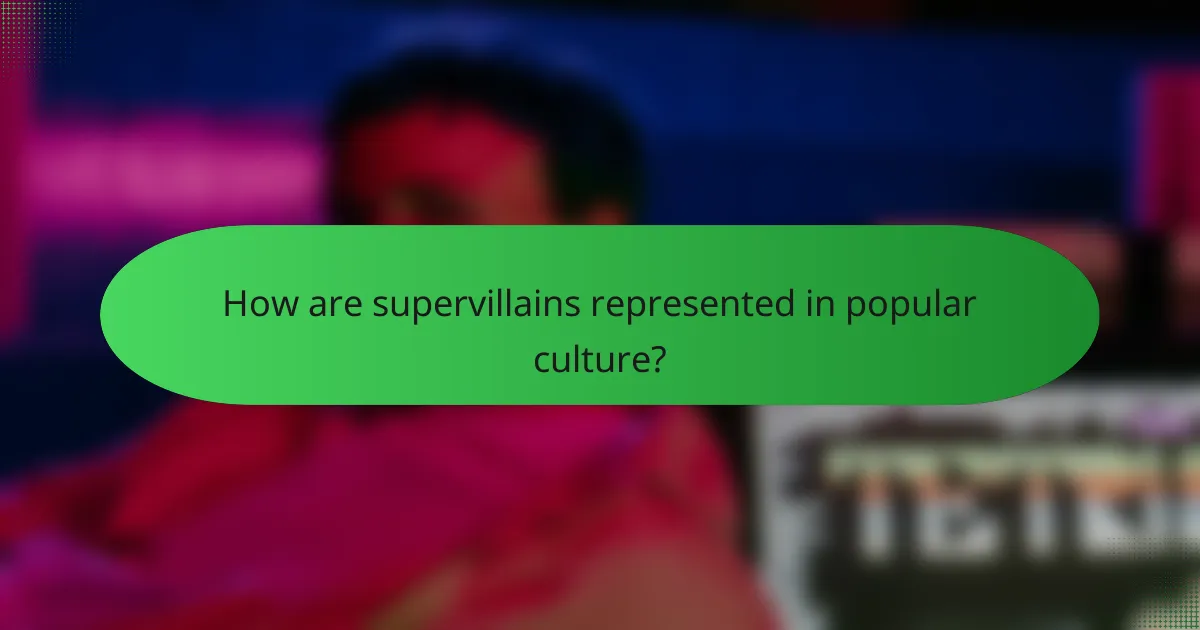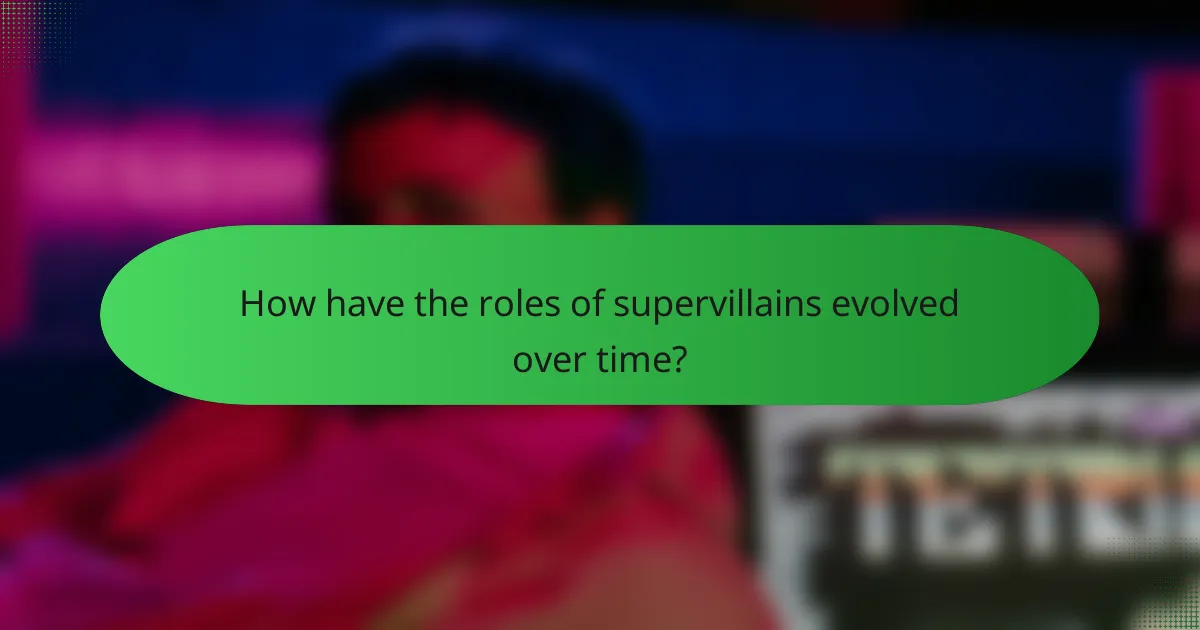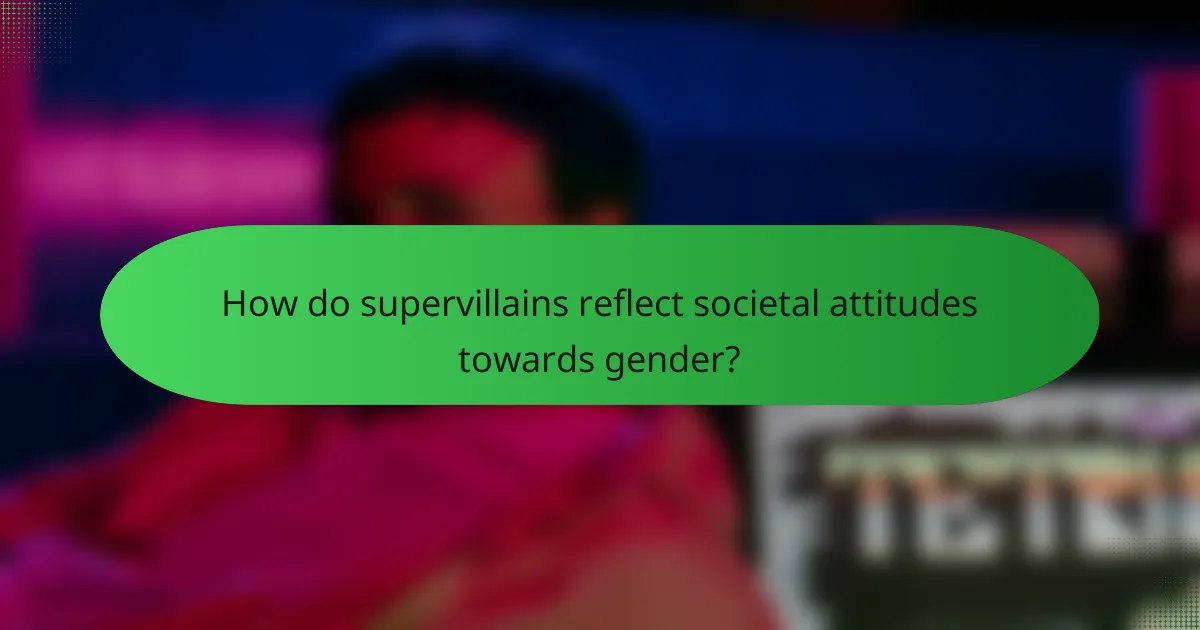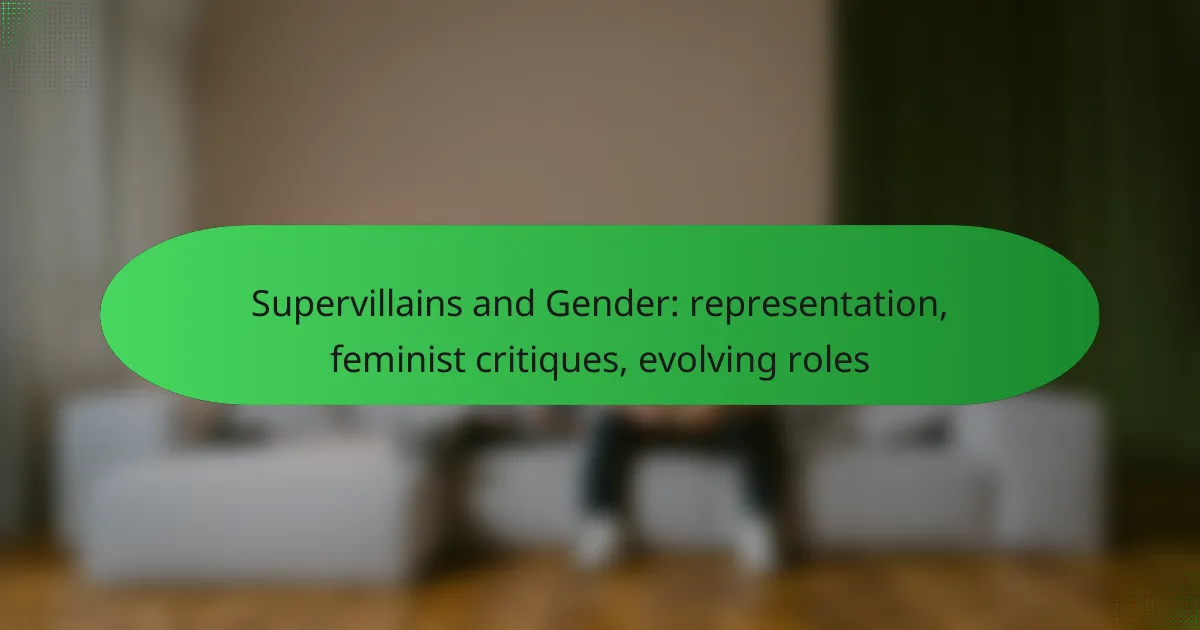Supervillains in popular culture serve as intriguing reflections of societal attitudes towards power, morality, and gender. While traditionally depicted as one-dimensional threats, their roles have evolved, revealing complexities that challenge stereotypes and engage with feminist critiques. However, the portrayal of female supervillains often still perpetuates objectification and reinforces harmful gender norms, highlighting the ongoing need for nuanced representation in media.

How are supervillains represented in popular culture?
Supervillains in popular culture are often depicted as complex characters with diverse motivations and backgrounds, reflecting societal attitudes towards power and morality. Their representation varies significantly across different media, influencing public perception and engagement with these characters.
Comic book portrayals
In comic books, supervillains are frequently characterized by their distinctive traits, elaborate backstories, and moral ambiguity. Characters like Harley Quinn and Magneto illustrate how villains can embody feminist themes or challenge societal norms, often becoming fan favorites due to their depth and relatability.
Comic book narratives often explore the psychological aspects of villainy, allowing readers to empathize with their struggles. This complexity can lead to discussions about the nature of evil and the impact of societal pressures on individual choices.
Film and television adaptations
Film and television adaptations of supervillains tend to amplify their personalities and motivations, often using visual storytelling to enhance their appeal. Iconic portrayals, such as those of the Joker or Thanos, showcase how cinematic techniques can create a compelling narrative around villainy.
These adaptations frequently emphasize the duality of heroism and villainy, prompting viewers to question traditional moral binaries. The portrayal of female supervillains, like Catwoman and Mystique, has evolved, reflecting broader cultural shifts towards gender representation in media.
Video game representations
In video games, supervillains are often designed as formidable opponents, with gameplay mechanics that highlight their powers and abilities. Titles like “Batman: Arkham” series showcase villains with intricate designs and backstories, enhancing player engagement through immersive narratives.
Games frequently allow players to explore the motivations of supervillains, offering a more interactive understanding of their character arcs. This medium also provides opportunities for players to confront moral dilemmas, blurring the lines between hero and villain.
Merchandising and branding
Merchandising around supervillains has become a significant aspect of popular culture, with products ranging from action figures to apparel. Brands often capitalize on the allure of these characters, creating a market that appeals to both children and adults.
Successful branding strategies often emphasize the unique traits of supervillains, fostering a sense of identity among fans. However, it is essential for brands to navigate the fine line between glorifying villainy and promoting positive values.
Fan interpretations
Fan interpretations of supervillains can significantly shape their cultural significance, often leading to creative expressions through fan art, fiction, and cosplay. These interpretations allow fans to explore alternative narratives and character developments, enriching the overall lore.
Online communities often engage in discussions that critique or celebrate the representation of supervillains, particularly regarding gender and diversity. This grassroots engagement can influence how creators approach these characters in future media, reflecting evolving societal values.

What feminist critiques exist regarding supervillain portrayals?
Feminist critiques of supervillain portrayals often focus on the objectification and stereotyping of female characters, as well as the broader implications these representations have on societal gender perceptions. These critiques highlight how female supervillains are frequently depicted in ways that reinforce harmful stereotypes and limit their roles within narratives.
Objectification of female supervillains
Female supervillains are often objectified, portrayed primarily through a lens of sexuality rather than as complex characters. This objectification can manifest in their costumes, which frequently emphasize physical attributes over functionality or character depth. For instance, many female villains wear revealing outfits that prioritize visual appeal over practical design.
This focus on appearance can detract from their motivations and backstories, reducing them to mere visual spectacles rather than fully realized individuals. Such portrayals can perpetuate a culture that values women primarily for their looks, undermining efforts toward gender equality in media representation.
Stereotyping and tropes
Female supervillains often fall into established stereotypes and tropes, such as the “femme fatale” or the “crazy woman.” These archetypes limit the diversity of female characters and reinforce negative perceptions of women in power. For example, the femme fatale trope typically portrays women as manipulative and dangerous, which can skew public understanding of female ambition and leadership.
Additionally, these tropes can overshadow the potential for more nuanced storytelling. When female villains are confined to stereotypes, it diminishes opportunities for exploring their complexities, motivations, and relationships, ultimately leading to a less engaging narrative.
Impact on gender perceptions
The portrayal of female supervillains can significantly influence societal gender perceptions, shaping how audiences view women in positions of power. When female villains are depicted as overly sexualized or irrational, it can reinforce harmful stereotypes that suggest women are unfit for leadership roles. This can contribute to a culture that undervalues women’s contributions in various fields.
Moreover, these portrayals can affect young viewers’ understanding of gender roles, leading to internalized beliefs about femininity and power. To counteract these effects, creators should strive for more balanced representations that showcase female supervillains as multifaceted characters with diverse motivations and strengths.

How have the roles of supervillains evolved over time?
The roles of supervillains have changed significantly, reflecting broader societal shifts in gender roles and narrative structures. Initially portrayed as one-dimensional threats, supervillains have become more complex characters, often embodying feminist critiques and evolving into anti-heroes.
Historical context of gender roles
Historically, supervillains were predominantly male, mirroring traditional gender roles that positioned men as aggressors and women as victims. Female villains often played supporting roles, characterized by seduction or emotional manipulation, reinforcing stereotypes rather than offering depth.
As societal views on gender evolved, so did the portrayal of female supervillains. Characters like Catwoman and Poison Ivy began to showcase more agency and complexity, challenging the notion that women could only be sidekicks or love interests.
Changes in narrative focus
The narrative focus in superhero stories has shifted from clear-cut good versus evil to more nuanced portrayals of morality. This change allows supervillains to be depicted with motivations that resonate with audiences, such as personal trauma or societal injustice.
Modern storytelling often blurs the lines between hero and villain, leading to richer character development. For example, characters like Magneto and Killmonger are presented with relatable backstories, prompting audiences to empathize with their motives, even if their methods are questionable.
Emergence of anti-heroes
The rise of anti-heroes has transformed the landscape of villainy in superhero narratives. Characters like Deadpool and Harley Quinn exemplify this trend, combining villainous traits with heroic qualities, creating a more relatable and complex character archetype.
Anti-heroes often challenge traditional moral boundaries, allowing for exploration of themes like redemption and identity. This evolution reflects a broader acceptance of flawed characters, making them more appealing to contemporary audiences who appreciate depth and ambiguity in storytelling.

What are the implications of gender representation in supervillain narratives?
Gender representation in supervillain narratives significantly influences societal perceptions of gender roles and power dynamics. These narratives often reflect and shape cultural attitudes towards femininity and masculinity, revealing underlying biases and stereotypes.
Influence on audience perceptions
The portrayal of supervillains can reinforce or challenge existing gender stereotypes. For instance, female supervillains are frequently depicted as manipulative or overly emotional, which can perpetuate negative stereotypes about women. Conversely, strong female villains can also serve as empowering figures, showcasing complexity and strength.
Audiences may internalize these representations, leading to skewed perceptions of gender capabilities. Positive portrayals can inspire viewers to rethink traditional gender roles, while negative depictions may reinforce harmful beliefs. Understanding these dynamics is crucial for creators aiming to foster more balanced narratives.
Impact on female empowerment
Supervillain narratives can play a dual role in female empowerment. On one hand, they can provide women with powerful, complex characters who defy societal norms, thus serving as role models. Characters like Catwoman or Mystique illustrate how female villains can embody strength and independence, challenging the status quo.
On the other hand, if these characters are primarily defined by their villainy or are overly sexualized, they may undermine the feminist message. It is essential for creators to balance these portrayals to ensure that female supervillains contribute positively to discussions around empowerment and gender equality.

How do supervillains reflect societal attitudes towards gender?
Supervillains often embody and challenge societal attitudes towards gender, showcasing both traditional and evolving perceptions of power and morality. Their portrayal can reveal underlying biases and cultural narratives about masculinity and femininity, influencing audience perceptions of gender roles.
Representation of power dynamics
Supervillains frequently illustrate power dynamics that reflect societal views on gender. Male villains often represent brute strength and dominance, while female villains may embody cunning and manipulation, highlighting a dichotomy in how power is perceived across genders. This can reinforce stereotypes, but it can also subvert them by presenting female villains as equally formidable.
For instance, characters like Harley Quinn and Mystique challenge traditional power structures by showcasing complexity and depth, allowing for a broader interpretation of female strength. Their narratives often blur the lines between victimhood and empowerment, prompting audiences to reconsider what power looks like in a gendered context.
Gender roles in villainy
Gender roles in villainy reveal how society constructs notions of good and evil based on gender. Male supervillains are often portrayed as ruthless and ambitious, while female villains may be depicted as vengeful or emotionally driven. This can perpetuate harmful stereotypes that associate masculinity with aggression and femininity with emotional instability.
However, recent portrayals have begun to challenge these norms. Characters like Killmonger from “Black Panther” and Catwoman from the “Batman” series showcase nuanced motivations that transcend traditional gender roles. These representations encourage audiences to explore the complexities of villainy beyond simplistic gender binaries.
